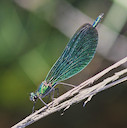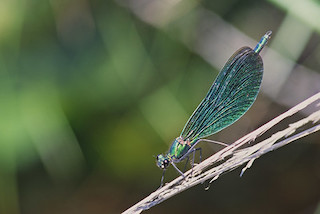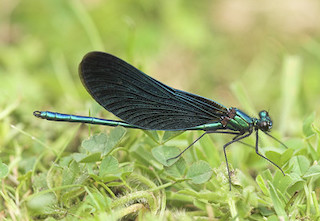 Beautiful Demoiselle damselflies are on the wing from early summer until the early autumn.
Beautiful Demoiselle damselflies are on the wing from early summer until the early autumn.
Photo: © Natural England/Chris Gomersall
Scientific name: Calopteryx virgo
What to look for:
- Colouring: Males have dark blue-brown wings (paler at the tip) and a metallic blue-green body; females have green-brown wings and a green body, tipped in bronze.
- Size: Length, 4.5 cm
- When: These damselflies are on the wing between May and September.
- Where: Close to gravelly and sandy fast-flowing streams and small rivers. Can however be found further afield when seeking prey.
- Similar species: Banded Demoiselle.
 The gorgeously named Beautiful Demoiselle is one of only two species of damselfly in the UK with vibrantly coloured wings (the other is the Banded Demoiselle). The dark copper-blue wings of the mature male are particularly striking, but the greeny-brown wings of the female and immature male also have a rich beauty. Watch out for them beside gravelly streams and small rivers.
The gorgeously named Beautiful Demoiselle is one of only two species of damselfly in the UK with vibrantly coloured wings (the other is the Banded Demoiselle). The dark copper-blue wings of the mature male are particularly striking, but the greeny-brown wings of the female and immature male also have a rich beauty. Watch out for them beside gravelly streams and small rivers.
The females lay their eggs on water plants, and will sometimes completely submerge in order to do so. Hatching two weeks later, the larvae takes two years to mature, living underwater and overwintering in the muddy stream bottom.
 Did you know…?
Did you know…?
…There are some 20 species of damselfly found across Britain and Ireland.
…Damselflies and dragonflies are closely related. When at rest, damselflies usually hold their wings along their abdomen, whereas dragonflies hold their wings open.
More information and references:
Chinery, M., 2004. Collins Complete Guide to British Insects. Collins, London.
Jones, S., 2010. Insects of Cornwall and the Isles of Scilly. Alison Hodge, Penzance.
Published: June 2015
Author: Amanda Scott
Photos: Upper, © Natural England/Chris Gomersall; lower, © Natural England/Allan Drewitt
